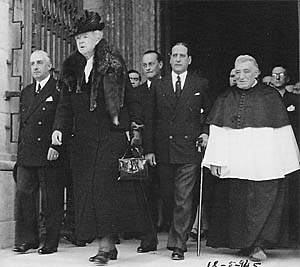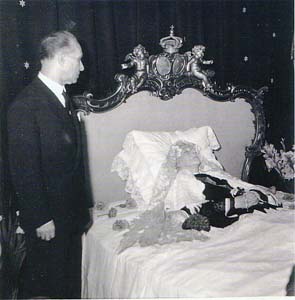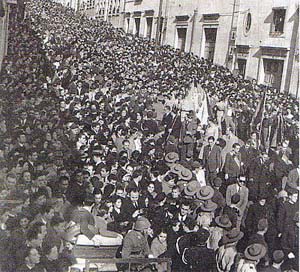Regina

Regina was born in 1978, in Portugal. She has been a royalty fan since forever. Regina has a degree in economics and a master's in Christian studies, and she is presently working as an accountant. Regina has a large collection of memo books and day planners, and is interested in alternative medicine, but flowers are her passion. Her next project will be a short course in floriography (language of flowers).
View all articles by ReginaExile
In exile the members of the royal family went their separate ways. Queen Maria Pia returned to Italy, her native country, where she died nine months later. Only minutes before she died she asked her servants to turn her body in the direction of Portugal. The others went to England, where the Duke of Orléans (Queen Amelia’s brother) received them at his house in Woodnorton.
Many royalists changed to the republican side just one day after the revolution. There was, however, still some monarchist resistance to the new republican regime, but not enough to convince King Manuel that he should fight for restoration of the monarchy. During the following year, 1912, Manuel travelled a lot. While he was on his way to Switzerland, he stopped in Sigmaringen to visit his great-aunt Antónia de Bragança. Here he met her niece, Princess Augusta Victoria of Hohenzollern-Sigmaringen. The two liked each other, and in 1913 they got engaged. They married on 4 September 1913. For the first time since the regicide, Queen Amelia discarded her mourning clothes and chose a bright dress to attend the wedding of her son and 'Mimi', as she called her daughter-in-law.
The beginning of the First World War filled King Manuel with mixed feelings. On the one hand, he supported England since England and Portugal were historical allies. On other hand, his wife was German and both his brothers-in-law were in German military service. Queen Amelia wisely advised her son only to get involved in the humanitarian part of the conflict, which he did. Soon after the war started, Queen Amelia visited France, her native country, to see the atrocities for herself. The visit made a huge impression on her, and she started helping out in several hospitals in Britain. Another sad event for Queen Amelia occurred in 1917. Her brother-in-law, Prince Afonso, decided to marry Nevada Hayes Chapman, a lady who had already been divorced three times. As this was rather scandalous at the time, Amelia was forced to break off all contacts with him.
In April 1919, the Countess of Paris, Amelia's mother, died in Villamanrique, Spain. In February of the following year, Prince Afonso (Amelia's brother-in-law) died in Posillipo, Italy. Because of his controversial marriage, none of his Portuguese relations were present when he died. After these two deaths, Amelia decided to leave England for good. The doctors had advised her not her to spend another winter season in England, and she was also missing France, where she had good memories of her relaxed youth. Her wish was to live close to Palace of Versailles. She chose a mansion in Chesnoy, known as Château de Bellevue, and spent the next 30 years of her life there. In Chesnay, the Queen mixed with the community, helping the Red Cross and other charities. King Manuel kept his mother informed about his decisions and politics, although the movement to restore the monarchy in Portugal was dying out.
The last time Amelia saw her son Manuel alive was in 1932 at the Wimbledon tennis championships. Her instinct told her that something was wrong with him, and indeed he was sick. He called his doctor, who diagnosed tracheal edema and advised him to take some rest. This was not enough, however, and he died later that year, of unknown causes. Queen Amelia had a weird premonition about this tragedy; when the letter with the news arrived at her house in Chesnay, she said “Je sais… mon fils, est mort” – I know my son is dead - even before she opened the envelope. Queen Amelia organized all the funeral ceremonies in the Catholic Cathedral of Westminster, just as she had done in Lisbon when her husband and eldest son died. The Marquis of Lavradio, who was the personal secretary of King Manuel, wrote in his memoirs: “when the coffin was passing through the cathedral’s door, Her Majesty D. Amelia took her hands to her lips and sent a last kiss to her son, with a gesture so full of tenderness that I was not able to forget.” Prime Minister Salazar decided to bring the king’s body back to Portugal and give him a state funeral. Queen Amelia and Queen Augusta Victoria were, however, not allowed to be present. King Manuel was laid to rest in the church of São Vicente de Fora, the pantheon of the Bragança family. In the following year it became clear that Manuel’s last will bequeathed to Portugal a huge quantity of his patrimony. These goods were later used to create the House of Bragança Foundation. Queen Augusta Victoria returned to Germany, and she would later marry Count Karl Robert Douglas.
 When the war was over, Salazar invited Amelia to visit Portugal. She arrived on 19 May 1945, a few minutes before midnight; it was the same date on which she had first arrived in Portugal as the fiancée of Don Carlos. On the first morning of her stay, she went to São Vicente de Fora to visit the tombs of her husband, sons, and infant daughter. After that visit she was received by the higher ecclesiastic authorities including the Patriarch Cardinal of Lisbon Gonçalves Cerejeira, the highest religious authority in Portugal. When the Queen left the church she heard applause from the people on the street. The following days she visited some old friends in Cascais, and went to the Palace of Pena, in Sintra, where she greeted her old employees. Amelia, making a pilgrimage through the rooms of the palace, remembered that everything she loved was not there any more. She ended the visit crying at the palace’s chapel. On 21 May she met Salazar in person for the first time. They spent all day together, and after this visit they would exchange many letters. He had such influence over her that he convinced her to change her will in order to benefit the other, rival branch of the family, the Miguelistas side, who were in a financially precarious situation. The Queen also paid a visit to the Marian Sanctuary of Fatima. The apparitions of the Virgin in Portugal happened after her exile, but Queen Amelia felt a great devotion for Our Lady of Fatima. When she left for France, the railway station was filled with people, many of whom wanted to say their farewells. Inside the train, the Queen waved goodbye and cheered “Viva Portugal!” without any grudge. In her honour Salazar decided to rename the old National Association against Tuberculosis (founded by the Queen in 1899) to Preventório Rainha D. Amélia.
When the war was over, Salazar invited Amelia to visit Portugal. She arrived on 19 May 1945, a few minutes before midnight; it was the same date on which she had first arrived in Portugal as the fiancée of Don Carlos. On the first morning of her stay, she went to São Vicente de Fora to visit the tombs of her husband, sons, and infant daughter. After that visit she was received by the higher ecclesiastic authorities including the Patriarch Cardinal of Lisbon Gonçalves Cerejeira, the highest religious authority in Portugal. When the Queen left the church she heard applause from the people on the street. The following days she visited some old friends in Cascais, and went to the Palace of Pena, in Sintra, where she greeted her old employees. Amelia, making a pilgrimage through the rooms of the palace, remembered that everything she loved was not there any more. She ended the visit crying at the palace’s chapel. On 21 May she met Salazar in person for the first time. They spent all day together, and after this visit they would exchange many letters. He had such influence over her that he convinced her to change her will in order to benefit the other, rival branch of the family, the Miguelistas side, who were in a financially precarious situation. The Queen also paid a visit to the Marian Sanctuary of Fatima. The apparitions of the Virgin in Portugal happened after her exile, but Queen Amelia felt a great devotion for Our Lady of Fatima. When she left for France, the railway station was filled with people, many of whom wanted to say their farewells. Inside the train, the Queen waved goodbye and cheered “Viva Portugal!” without any grudge. In her honour Salazar decided to rename the old National Association against Tuberculosis (founded by the Queen in 1899) to Preventório Rainha D. Amélia. Last years
In 1951, Amelia's sister Princess Isabelle died, after which her periods of dementia became more frequent. During her mental torments and living alone only with her servants and secretary, she asked everyone who could hear her: “why was I exiled? Why did they kill my sons?” Amelia didn’t say “son” but “sons,” which led some to think that she knew more about the suspicious death of her younger son than was officially said.
 Apart from this despair, she had moments of joy when she was visited by admirers. She was very happy with the visit of the movie maker Leitão de Barros, who wanted to interview her for a television programme. The interview was a testimony to her resilient humour. When they began to film the Queen, she laughed and said “but why do you want to film this ruin?” Leitão de Barros confessed she was a very bright and sweet person, who was cooperative till the end of the film. The only thing she hated were the strong lamps. She called them “cet odieux soleil artificial!” The interview was a great success and showed how much Amelia still felt for Portugal. The journalist asked her if she thought often about Portugal, to which she replied in perfect Portuguese: “Remember? The ones who remember are the ones who once forgot. And I have never forgotten!” He wanted to know if she wanted to come back to Portugal ... “what do you mean, come back?...my heart is still there, my friend!”
Apart from this despair, she had moments of joy when she was visited by admirers. She was very happy with the visit of the movie maker Leitão de Barros, who wanted to interview her for a television programme. The interview was a testimony to her resilient humour. When they began to film the Queen, she laughed and said “but why do you want to film this ruin?” Leitão de Barros confessed she was a very bright and sweet person, who was cooperative till the end of the film. The only thing she hated were the strong lamps. She called them “cet odieux soleil artificial!” The interview was a great success and showed how much Amelia still felt for Portugal. The journalist asked her if she thought often about Portugal, to which she replied in perfect Portuguese: “Remember? The ones who remember are the ones who once forgot. And I have never forgotten!” He wanted to know if she wanted to come back to Portugal ... “what do you mean, come back?...my heart is still there, my friend!”
The Queen's health continued to deteriorate and by the end of September 1951, she was kept alive only with the help of a huge quantity of medication. On 5 October her last words were to her faithful secretary, Julio da Costa Pinto. She recognized him, thanked him, and smiled while he was crying and kissed her hands. The Queen died 20 days later, only a few seconds after someone had given her some water. Smiling, and without a murmur or complaint, the Queen was finally at rest. She was 87 years old.
 The first funeral service took place at the cathedral of St. Louis in Paris, in the presence of several members of the French and Portuguese royal families. On 26 November the Queen's body departed for Portugal. By a personal order of Salazar, Amelia received the ceremonies and honours of a reigning Queen. No one expected that so many people would be on the streets of Lisbon to follow the Queen’s last journey to her tomb. The unexpected number of people who went to São Vicente de Fora to pay their respects made the government decide to keep her body on view for thirty days instead of the initial three! Through the glass window of her coffin, it was possible to see the Queen, her hands and face as white as marble in contrast to her black dress, the same dress she was wearing on the day her husband and son were murdered. Through the years she had kept this dress, stained with their blood, to wear at her own funeral. In March 1952, she was laid to rest in a tomb which resembled the tombs of her husband and elder son. All of them were made of marble from the village at her beloved Vila Viçosa. On the sides of her tomb, the inscription says the most true thing ever written about her: "Aqui descansa em Deus, D. Amelia de Orleães e Bragança, rainha no trono na caridade e na dor”. – “Here rests in God, D. Amelia of Orléans and Bragança, Queen on the Throne, in Charity and in Pain.”
The first funeral service took place at the cathedral of St. Louis in Paris, in the presence of several members of the French and Portuguese royal families. On 26 November the Queen's body departed for Portugal. By a personal order of Salazar, Amelia received the ceremonies and honours of a reigning Queen. No one expected that so many people would be on the streets of Lisbon to follow the Queen’s last journey to her tomb. The unexpected number of people who went to São Vicente de Fora to pay their respects made the government decide to keep her body on view for thirty days instead of the initial three! Through the glass window of her coffin, it was possible to see the Queen, her hands and face as white as marble in contrast to her black dress, the same dress she was wearing on the day her husband and son were murdered. Through the years she had kept this dress, stained with their blood, to wear at her own funeral. In March 1952, she was laid to rest in a tomb which resembled the tombs of her husband and elder son. All of them were made of marble from the village at her beloved Vila Viçosa. On the sides of her tomb, the inscription says the most true thing ever written about her: "Aqui descansa em Deus, D. Amelia de Orleães e Bragança, rainha no trono na caridade e na dor”. – “Here rests in God, D. Amelia of Orléans and Bragança, Queen on the Throne, in Charity and in Pain.”
Sources
Enciclopédia Luso-Brasileira
Grande Reportagem magazine, nº61, article: "No tempo dos reis"
Indy magazine no. 507, article: No dia em que o rei foi morto
Nobre, Eduardo. Amélia, Rainha de Portugal. Quimera, 2006
Nogueira, Franco Salazar vol. IV. Civilização Editora, 1986
Tavares Dias, Marina Dom Carlos Lisboa 1908. Quimera, 2007
Verger, Carlos Alberto A Dor de uma Rainha Civi World Brazil, 1975
Photo Credits
All photos are public domain.
